Active Transport
Introduction
Molecules can cross a plasma membrane against a concentration gradient only by expending energy – a process called active transport.
Active Transport can occur in several forms, including:
- Active Transport Proteins (pumps)
- Endocytosis
- Exocytosis
Let’s explore active transport in more detail now…
Active Transport
As we just noted, active transport occurs when the cell needs to move molecules or compounds against a concentration gradient. This process requires energy.
There are three active transport mechanisms that we will explore in more detail:
- Active Transport Proteins (pumps)
- Endocytosis
- Exocytosis
Active transport proteins (pumps)
Active transport proteins can move molecules across the plasma membrane using energy from molecules such as ATP. Like passive channel proteins, active transport proteins bind only to certain molecules with a particular shape, however, the addition of energy causes a shape change in the active carrier protein that forcibly pushes the molecule across the membrane. This mechanism allows active transport proteins to move molecules from regions of low concentration to regions of high concentration.
Since these molecules work to ‘pump’ molecules from one side of the membrane to the other, they are also referred to as ‘active pumps’
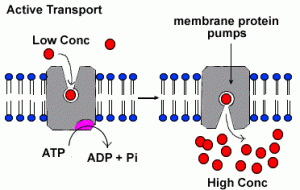
Endocytosis
Endocytosis is used by the cell to bring larger structures or materials inside the cell. The term endocytosis is derived from a Greek term which means ‘into the cell’. In all cases, the process of endocytosis requires the cell to expend energy.
In endocytosis, a section of plasma membrane bulges inward around substances that are outside of the cell. The inward-budding portion of membrane eventually breaks free of the plasma membrane to become an enclosed vesicle.
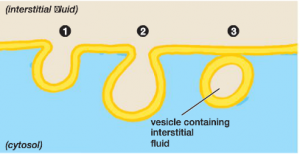
There are 3 basic types of endocytosis:
- Phagocytosis – used by the cell to engulf larger, solid objects, such as bacteria
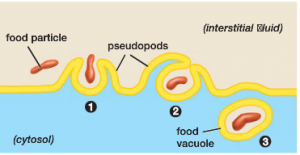
- Pinocytosis – used by the cell to engulf water and dissolved solutes from the outside environment
- Receptor-mediated endocytosis – occurs when specific messenger molecules are bound by receptor proteins; the cell will engulf these receptor proteins along with the bound messenger molecule.
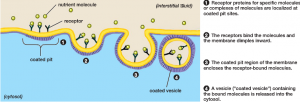
Exocytosis
Exocytosis (from a Greek term meaning ‘out of the cell’) is the process by which cells release substances into their surroundings. As a vesicle containing waste products or proteins to be exported outside of the cell approaches the plasma membrane, a portion of the vesicle’s membrane fuses with the plasma membrane. It then creates an opening to the exterior of the cell, allowing the vesicle’s contents to be discharged.
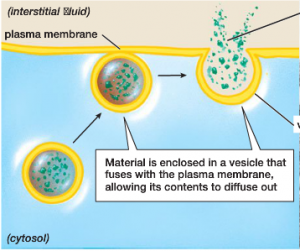
This process is used, for example, by pancreas cells in your body after every meal and snack. These cells are specialized at producing the hormone insulin, which signals other cells in the body to take up sugar (glucose). Insulin is released from these cells using the process of exocytosis.
Active Transport
As we just noted, active transport occurs when the cell needs to move molecules or compounds against a concentration gradient. This process requires energy.
There are three active transport mechanisms that we will explore in more detail:
- Active Transport Proteins (pumps)
- Endocytosis
- Exocytosis
Active transport proteins (pumps)
The following video discusses the Sodium-Potassium pump, an example of an active transport/pump protein:
Endocytosis is used by the cell to bring larger structures or materials inside the cell.
There are 3 basic types of endocytosis
- Phagocytosis – used by the cell to engulf larger, solid objects, such as bacteria
- Pinocytosis – used by the cell to engulf water and dissolved solutes from the outside environment
- Receptor-mediated endocytosis – occurs when specific messenger molecules are bound by receptor proteins; the cell will engulf these receptor proteins along with the bound messenger molecule.
The following video describes each type of endocytosis:
Exocytosis
Exocytosis (from a Greek term meaning ‘out of the cell’) is the process by which cells release substances into their surroundings. This process is used, for example, by pancreas cells in your body after every meal and snack. These cells are specialized at producing the hormone insulin, which signals other cells in the body to take up sugar (glucose). Insulin is released from these cells using the process of exocytosis.
The video above also presents the process of exocytosis.
Summary
Active Transport involves the use of energy to transport molecules across the plasma membrane. This process can occur in several forms, including:
- Active Transport Proteins (pumps) – used to transport larger molecules or compounds against the concentration gradient.
- Endocytosis – The ingestion of particles or fluid into the cell
- Exocytosis – The excretion of particles or waste materials from the cell